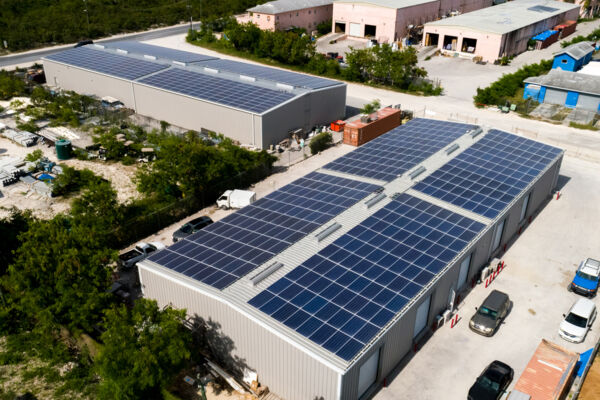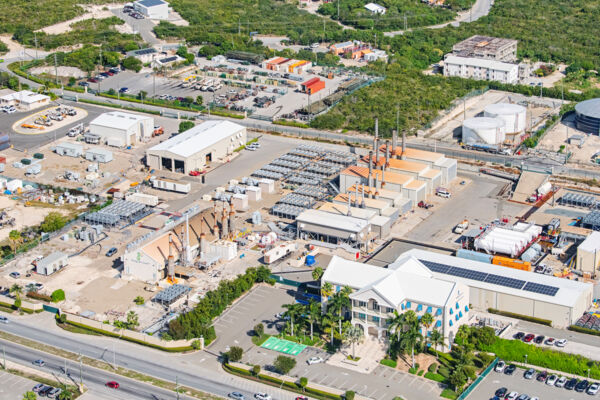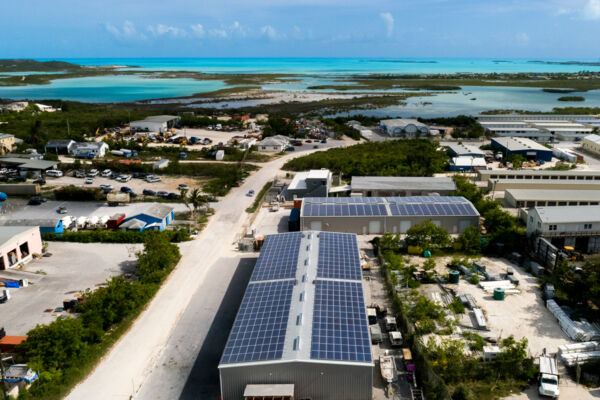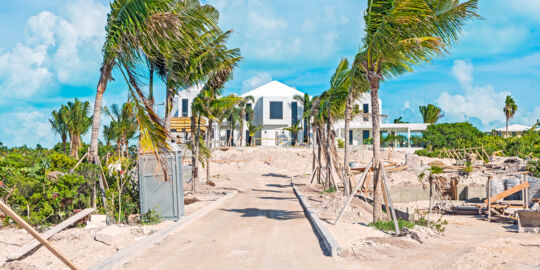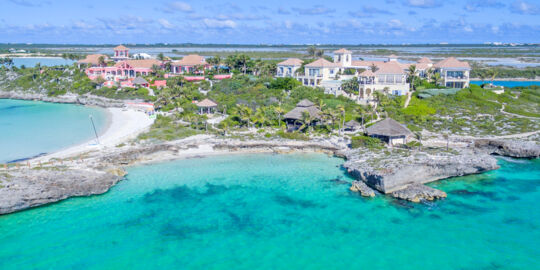Electricity & Solar Power in the Turks & Caicos Islands
In the Turks and Caicos , all public electricity generation is run by Fortis TCI, a vertically integrated company that provides both power generation and distribution. Electricity is generated almost exclusively via diesel generators, and solar and renewable energy account for around 1 MW of installed capacity (approximately 2% of power consumed in the Turks and Caicos based on 2022 figures). Current generation capacity is 86 MW across the country, with a peak demand of 46 MW (2022 data).
The electricity standard in the Turks and Caicos is 120v, 60Hz and U.S. style power plugs.
Solar-derived power is increasing in popularity, with many private installations visible throughout the country, especially on new villa projects. Several local companies specialize in both supply and installation of alternative energy systems.
History of Electricity Generation in the Turks and Caicos
In 1987, the Provo Power Company (P.P.C. Limited) acquired a 50-year exclusive license to generate and distribute electricity for Providenciales, North Caicos, and Middle Caicos, which expires in 2037. Separately, Atlantic Equipment and Power (AEP) acquired an exclusive license for South Caicos which is due to expire in 2036.
For the Turks Islands of Grand Turk and Salt Cay, electricity generation was run by Turks and Caicos Utilities (TCU), a government-owned entity.
Fortis Turks and Caicos (FTCI), a subsidiary of Canadian utility holding company Fortis Inc., acquired P.P.C and AEP in 2006, and concluded an acquisition of TCU in 2012.
Cost of Electricity
Electricity is priced via two components: ‘Electric’ which includes generation and distribution, and ‘Fuel Factor’ which varies based on global fuel prices. Rate changes apart from the fuel factor require approval by Government.
For July 2023 on Providenciales, the cost per kWh was $0.49. This is composed of a $0.2910 ‘electric’ charge and a $0.1986 ‘fuel factor’.
Future
Fortis TCI announced in 2017 that 1 MW of solar capacity is scheduled to be installed in the islands via the utility company, which would include a 700 kW array on North Caicos and 300 kW throughout the other islands. These projects are ongoing.
Utilizing Alternative Energy (Solar Power)—Interconnected or Isolated
There are two approaches for persons wishing to install a solar array at their residence or business:
Interconnected
Participate in Fortis TCI’s Interconnect Program
- C.O.R.E—Customer Owned Renewable Energy allows customers to purchase their own equipment to connect to the grid. Residential customers can connect up to 10 kW of capacity, and commercial customers can connect up to 60 kW. All generated power must be fed into the grid (sold to Fortis), which pays $.07 + the current fuel factor.
- U.O.R.E—Utility Owned Renewable Energy allows customers to lease their roof space to Fortis TCI, which would install a solar array owned by the utility. Fortis TCI pays both a fee based on installed capacity, and an annual ‘bonus’ based on actual electricity generated via the array.
For persons interested in participating in C.O.R.E or U.O.R.E, it is highly recommended to contact Fortis TCI in advance of planning and construction. Applications will take 4-12 weeks to process.
Isolated, Independent System
Alternatively, homeowners and business can install their own solar array, inverters, and storage/battery system isolated from the public electric grid.
Government Incentives
Photovoltaic (solar) panels and some support equipment carry a 0% duty, unlike the normal 30% on most items imported into the islands. However, a 5% Customs Processing Fee (CPF) is payable.
There are no other direct Government subsidies or incentives. As there is no income or corporation tax in the country, there are no tax credits.
Considerations
Hurricanes
Hurricanes are the largest threat to the integrity and life of a solar array in the Turks and Caicos. Panels are commonly manufactured to withstand 140 mph (225 km/h) winds. The main consideration for mitigating and preventing hurricane damage is the attachment method.
In the aftermath of Hurricanes Irma and Maria in the U.S. Virgin Islands, the Federal Emergency Management Agency (FEMA) published an April 2018 report. This noted that certain clamping methods, such as clamping panels to each other instead of independently, resulted in adjoining panels shifting when a single panel broke free, and possibly increasing panel loss and damage. Furthermore, the report highlighted a number of recommendations, including that clamps be checked annually for tightness as clamps loosened on their own.
Cloudy Days
On days with cloud cover, photovoltaic panels will produce around 10-25% of their rated output. Unfortunately, this is often correlated with hurricanes and other adverse weather conditions which may affect the grid–thus the conditions which may cause blackouts may also reduce the effectiveness of your solar installation.
This is especially important with an independent system not connected to the grid, as you may quickly deplete your batteries.
Payback Period
The payback period will likely be between 8-12 years, although this depends on a number of factors.
Due to decreasing global costs of solar components, and a lack of a Turks and Caicos centric study, it’s difficult to judge the payback period for the TCI.
A 2022 report by the National Renewable Energy Laboratory (NREL), part of the U.S. Department of Energy, found an average benchmark price of $3.16 per installed watt of solar energy (AC watt, taking into account conversion from DC).
Example Calculation
With this pricing, an array of 6 kW would cost $18,960 (6000 × 3.16). This could theoretically produce 10,296 kWh of electricity per year (6 × 1716). This is based on the PVOUT figures for Providenciales from the table below.
The cost of purchasing this electricity from Fortis TCI (based on the June 2023 kWh price) would be $5,045.04 per year (10296 × .49). This would be an average monthly electric bill of $420.42.
Selling this electricity to Fortis TCI, as a participant in their C.O.R.E program, would net $2,779.92 per year (10296 × .27).
For those participating in C.O.R.E, the payback period would be around 7.9 years (with an annual 3.5% discount rate), depending on inflation, capital cost, variances in fuel prices, and other factors.
Offsetting the purchase price from Fortis TCI may seem lucrative, however, this doesn’t factor in battery storage costs, which have shorter lifespans compared to PV panels. Implementing a battery system, which would require sheltered indoor space, would decrease the profitability of such a system. Adding a battery system will add a significant initial cost.
Solar Panel Efficiency - Global Comparisons
A number of factors affect the efficiency of solar panels across locations. For example, PV panels located at higher altitudes receive more solar radiation and thus produce more power (all other things being equal). Atmospheric conditions, such as average cloud cover, also significantly impact the total output of a panel for a particular region.
The following table contains data from Global Solar Atlas. PVOUT is an estimated annual output of 1 kWp installed capacity (kWp is a standardized calculation and is the kilowatt ‘peak' of a panel). GHI is Global Horizontal Irradiance and is equal to the total amount of shortwave radiation received on a horizontal surface on the ground. Diffused Horizontal Irradiance, or DIF, refers to the part of the solar irradiation scattered by the atmosphere.
| Location and Solar Output | |||
| Location | PVOUT | GHI | DIF |
| Atacama Region, Chile | 2164 | 2491 | 429 |
| Copper Mountain Solar Facility, Nevada | 1863 | 2058 | 493 |
| Providenciales | 1716 | 2075 | 717 |
| Perth | 1715 | 1950 | 560 |
| Miami | 1617 | 1922 | 702 |
| Houston | 1462 | 1718 | 713 |
| New York City | 1421 | 1473 | 605 |
| Toronto | 1345 | 1391 | 577 |
| London | 982 | 1017 | 572 |
| Edinburgh | 873 | 889 | 541 |
Local Businesses


